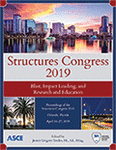Structures Congress 2019
Assessment of the Applicability of Recycled Rubber Fiber Reinforced Bearings (RR-FRBs) as Base Isolators of Residential Buildings in Developing Countries
Publication: Structures Congress 2019: Blast, Impact Loading, and Research and Education
ABSTRACT
Base isolation has proved to be among the most effective technologies for earthquake hazard mitigation. Nevertheless, due to its implementation costs, the adoption of this earthquake protection strategy is generally limited to large and expensive infrastructures including chip factories, nuclear power plants, hospitals, and emergency response centers. The research described in this work, aims to verify the applicability of low-cost base isolation devices to residential buildings in developing regions of the world. This study focuses on recycled rubber-fiber reinforced bearings (RR-FRBs). These devices can be produced using simple to implement manufacturing procedures at a fraction of the cost of conventional isolators. The design of RR-FRBs for a benchmark building located near the city of Pelabuhan Ratu in Southwest Java, Indonesia, is discussed in this work. This is based on closed form solutions that were developed in early stages of the research program. Finite element analyses have then been adopted to verify the results obtained using the theoretical findings available in literature and to determine the lateral response of the devices under cyclic loads. Nonlinear response history analyses (RHAs) have been performed to assess the seismic response of the benchmark building when isolated at the base with the low-cost devices. Different hazard levels have been considered for the analyses. Results of the analyses confirm the advantages of adopting RR-FRBs as base isolators of ordinary buildings. It is hoped that this work will contribute towards the real implementation of the technology and its application to residential buildings in developing regions of the world.
Get full access to this article
View all available purchase options and get full access to this chapter.
ACKNOWLEDGEMENTS
This research has been founded by a Faculty Grant of the California State University, Long Beach. The author is grateful for the support received from the CSULB Research Scholarship and Creative Activity Program.
REFERENCES
Calabrese, A., Serino, G., Strano, S., & Terzo, M. (2015). “Experimental investigation of a low cost elastomeric anti-seismic device using recycled rubber.” Meccanica, 50(9), 2201-2218.
Calabrese, A., Spizzuoco, M., Serino, G., Della Corte, G., & Maddaloni, G. (2015). “Shaking table investigation of a novel, low-cost, base isolation technology using recycled rubber.” Structural Control and Health Monitoring, 22(1), 107-122.
Computers and Structures, Inc. (2012). Perform–3D v5. Nonlinear analysis and performance assessment of 3D structures, Computers and Structures, Inc. Berkeley, CA, USA.
Pan, P., Zamfirescu, D. A. N., Nakashima, M., Nakayasu, N., & Kashiwa, H. (2005). “Base isolation design practice in Japan: introduction to the post-Kobe approach.” Journal of Earthquake Engineering, 9(01), 147-171.
Iervolino, I., Galasso, C., & Cosenza, E. (2010). “REXEL: computer aided record selection for code-based seismic structural analysis.” Bulletin of Earthquake Engineering, 8(2), 339-362.
Kelly, J. (1997). “Earthquake Resistant Design with Rubber.” Richmond, CA: Earthquake Engineering Research Center, National Information Service for Earthquake Engineering.
Kelly, J. M., & Calabrese, A. (2012). “Mechanics of fiber reinforced bearings.” Berkeley, CA: Pacific Earthquake Engineering Research Center.
MSC Software (2004). MSC Marc 2005 and MSC Marc Mentat 2005, MSC Software Corporation, Santa Ana, CA, USA
NTC (2008). “Nuove norme tecniche per le costruzioni.” DM 14 gennaio 2008, Gazzetta Ufficiale n. 29 del 4 febbraio 2008 – Supplemento Ordinario n. 30. (in Italian).
Spizzuoco, M., Calabrese, A., & Serino, G. (2014). “Innovative low-cost recycled rubber–fiber reinforced isolator: experimental tests and finite element analyses.” Engineering Structures, 76, 99-111.
Taniwangsa, W., Clark, P. W., & Kelly, J. M. (1996). “Natural rubber isolation systems for earthquake protection of low-cost buildings.” Earthquake Engineering Research Center, University of California.
Toopchi-Nezhad, H., Drysdale, R. G., & Tait, M. J. (2009). “Parametric study on the response of stable unbonded-fiber reinforced elastomeric isolators (SU-FREIs).” Journal of Composite Materials, 43(15), 1569-1587.
Zayas, V. A., Low, S. A., and Mahin, S. A. (1987). “The FPS earthquake resisting system experimental report.” Earthquake Engineering Research Center.
Information & Authors
Information
Published In
Structures Congress 2019: Blast, Impact Loading, and Research and Education
Pages: 222 - 234
Editor: James Gregory Soules, McDermott International
ISBN (Online): 978-0-7844-8224-7
Copyright
© 2019 American Society of Civil Engineers.
History
Published online: Apr 22, 2019
Published in print: Apr 22, 2019
Authors
Metrics & Citations
Metrics
Citations
Download citation
If you have the appropriate software installed, you can download article citation data to the citation manager of your choice. Simply select your manager software from the list below and click Download.
